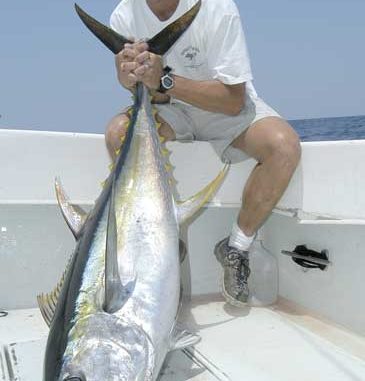
When spring arrives at the N.C. coast, offshore anglers turn to plentiful yellowfin.
Atlantic yellowfin tuna swim off the North Carolina coast year round, but anglers can’t get to the Gulf Stream when the wind is blowing at gale force.
However, by April most offshore tuna chasers expect days when the winds will have dropped. That means boats may leave the dock for the run to tuna fishing grounds, if not today then the next day when seas are calmer.
Anyone who comes to the coast with designs on taking back coolers of yellowfin steaks should expect to stay one or two days past their planned fishing day — in case they need to employ Plan B.
Yellowfin are serious fish for the average inshore angler accustomed to catching bass or crappies. These fish don’t come in refrigerator sizes, similar to their bluefin cousins. But they are tunas, averaging 20 to 70 pounds. They also may exceed 100 pounds (but most giants are far offshore).
If a captain finds himself trolling through a school of 50-pound yellowfins, he’ll stop running and looking and start fishing.
The main thing for anglers to remember, especially if they’re novices, is to listen and follow the advice of the captain because he generally knows what he’s doing.
Fred Parsons operates the Citation out of Hatteras Harbor Marina at Hatteras Village. He fishes for yellowfin lots of ways, based on how they behave during different times of year.
“First, of course,” he said, “we’ve got to find them. That means finding out where they were yesterday or are likely to be today, since they can move pretty fast.”
Parsons prefers blended water (cooler than Gulf Stream but warmer than coastal water) just inshore of the Gulf Stream above some type of structure.
He fishes beyond the Diamond Shoals Tower, and also works the Southeast Rocks, the Rockpile, the break zone at 30 to 55 fathoms or anywhere else an extensive rocky bottom holds bait and predators.
“Diamond Shoals has 8 to 10 miles of rocky bottom, and the Rockpile to the southwest is about 1×3 miles, but there are lots of rocky areas to fish,” he said.
“(Yellowfin) aren’t schooled by size, so you can run into mixed fish, 20 to 50 or even 100 pounds, all in the same place during a single bite.”
The idea that bigger fish inhabit deeper water isn’t true this time of year. Tuna are near baitfish; that matters more than depth.
Many options exist for catching yellowfins, but some, such as kite fishing, captains won’t try just any day. Some methods are best at certain times and places, Parsons said.
“Chunking (free-lining cut fish from a drift in a chum line) is better in fall and winter when you want spread-out fish to find you,” he said, “Trolling is good (during late winter and early spring) with the fish feeding deep on all kinds of fish and squid.”
Parsons doesn’t fish with a green stick, since it’s really a commercial method and, while exciting to see, takes too many fish too fast and is awkward on anything other than winch tackle.
“But it’s fun to see groups of tuna coming out of the water to reach for hanging baits,” he said. “Commercial guys use it when bigger 6- to 8-inch (long) flying fish and flying squid are bursting out of the water 50 or 100 at a time and soaring up to 40 feet.”
Commercial green-stick fishing doesn’t depend upon wind speed or direction. Anglers can green stick under any conditions.
Kite fishing is somewhat similar because anglers get to see tuna leaping from the water to grab artificial baits hung by release clips to the kite and flying just above the surface. However, for kite and green stick fishing to be successful, baitfish must be on the surface in large numbers with tuna right behind them.
Those conditions are more common in the summer when really small baits are boiling on top of the water, although they sometimes occur during spring.
For kite fishing, the wind should be between 10 and 17 knots from a direction that allows a boat to tack across it while moving over bottom features that hold the tuna.
“You can fish upwind or crosswind, but not downwind (with a kite),” Parsons said.
He constantly adjusts speed and direction of his boat to keep a kite aloft while moving over the bottom at 4 to 5 knots at the right elevation so the baits just touch or rise out of the water. Skipper and mate keep their eyes glued to the kite to avoid it diving and crashing, which can happen with a change in wind speed or direction.
Kites also break easily and are costly to buy or fix, so anglers don’t want them smashed by inattention to the wind. Concentrating on a kite is wearing, and a crew can continue for only a couple of hours at a stretch.
“Besides,” Parson said, “it’s tricky, and either productive or not after a short time, so you don’t continue if it doesn’t produce right away.”
If he sees tuna smashing baits on top of the water, Parsons probably will rig a kite, but it doesn’t hurt to ask any skipper about kite fishing if conditions look good.
Trolling is the method skippers use the majority of the time. Standard fare is half the lines pulling medium-size chin-weighted naked ballyhoos and other lines pulling ballyhoos dressed with Sea Witches.
If the tuna are big, baits will be clamped to 50-pound class sit-down tackle so anglers can fight from a chair or standing, if the chair is taken.
Parson’s also keeps 25- to 30-pound stand-up gear handy to toss a throw bait in the water if tuna are coming to the boat. The technique is similar to chunking for bluefin, only the fish are smaller and easier to handle.
Parsons didn’t think there were as many fish last year as in the past, and said he believes the stocks are being overfished.
Charter skippers were commercial fishing during the winter and landed 3,000 pounds or more of tuna per trip.
“The average size (of yellowfins) went down fast,” he said, “and that’s usually a sign of over-fishing.”
Buddy Hooper, who operates the Hatteras Fever II out of Hatteras Inlet, also said commercial fishermen are overfishing yellowfin, but he attributed most of that practice to the long-line industry.
“Also, the northeast currents are stronger than I’ve seen in the past 3 or 4 years and (tuna) patterns are changing,” he said.
Changing currents also might have something to do with decreased catches, he said.
“It just takes longer to find (yellowfin) now,” he said.
Hooper said better fishing should occur the second half of April with bigger fish more common in June and July.
He also does a lot of kite fishing.
“Everyone gets a kick out of seeing tuna leap out of the water and take a plastic squid hanging from the kite,” he said.
His customers employ 30-pound-class stand-up tackle and 50-pound-class sit-down fishing.
However he noted stand-up fishing for yellowfin can be risky.
“It takes a good man to stand up fish in rough water,” he said. “But some of the best tuna fishing is on the roughest days.”
Hooper also fishes at the Rockpile and rocks southeast of the tower, which are about an hour away.
“All the boats are bigger and faster now,” he said, noting that he just put in a big Caterpillar engine and cruises at 23 knots “and we just ran 25 knots at 1600 rpm.”
Hooper agreed with Parsons that kite fishing is hard on the captain and the mate, just to keep the kite from crashing.
“We have to keep the kite at an angle so the baits just hit the water, and it’s difficult to develop those skills,” he said. “You have to be 100-percent focused and can’t let your eyes wander.”
That’s especially important with kites that are easily damaged or destroyed carrying a $150 price tag.
“If it’s only busted and not completely smashed, it still takes a long time to send it back and get it repaired,” he said.
Hooper also said kite fishing requires ideal weather and bait conditions, and most of the time he trolls ballyhoo with and without Sea Witches. The tackle is strong, but the point is to land the fish.
Many years ago when an angler fishing with Hooper was battling a tuna, the captain asked the angler what the heck he was doing.
“I’m playing it,” the angler said.
“Crank him in,” Hooper said. “You can play with him in the boat.”
April is also a peak period for yellowfin off the Crystal Coast area of Atlantic Beach/Beaufort/Morehead City.
Junior Johnson of the Live Wire said his anglers often land a limit of yellowfin before lunch.
“We also have lots of wahoo,” he said.
Most of the yellowfin weigh from 30 to 50 pounds. His boat also lands a few dolphin each April, he said, depending upon water temperature.
Johnson said he looks for blended water about 72 degrees Fahrenheit, also above bottom structures.
“The Big Rock is especially good week days, but it’s crowded on weekends,” he said. “I like the south end while most other people head for the northeast corner.”
Johnson also fishes at many other spots but prefers the 550-600 line “or anywhere along the break.”
Early in the season he trolls ballyhoo with fluorocarbon leaders because tuna are feeding deep. His ballyhoo baits are naked or dressed with blue-and-white or black-and-white skirts. Later in the season, when tuna come to the surface to eat flying fish, he’ll start kite fishing.
There’s been no change in numbers of yellowfin, said Morehead City skipper Gray Hall of Blue Water Sportfishing.
“They seem to be maintaining themselves, and I think there is the same abundance of fish, but they stay around a particular location only for a day or two and then move off,” he said.
Hall said the time tuna spend at rocky bottoms has more to do with food availability than anything else.
He fishes from the Swansboro Hole to the Big Rock, and the 250 line north to the 800 line.
“There are lots of good spots, but I usually fish anywhere along the 30 to 60 fathom break or out to 100 fathoms, wherever there’s good bait,” Hall said.
In the spring, he mostly trolls an eight- or 10-rod spread, including three rods with wind-on fluorocarbon leaders. He also uses some wire leaders because wahoo are plentiful during April.
Hall’s rigs include ballyhoo with blue-and-white Sea Witches but he pulls a mixture of lures. Hall also trolls a single daisy chain of squid as a teaser to make a tumult at the surface.
“You don’t need more than one (teaser) for yellowfin,” he said.
The best bite is usually during the morning. Hall makes sure when a fish is hooked, he keeps the boat in gear to get more hookups, and he doesn’t stop to clear the tackle until the bite stops.
Hall said he tries kites later in the year if the wind is conducive to the technique.
“But the wind direction must be just right to let you cross over the wreck with your baits,” he said.
In the summer, the best bite also occurs during the early morning. If the fishing is slow, Hall will switch to kite fishing later in the afternoon.
Obviously there’s satisfaction in running to the Gulf Stream with a friend in a small boat and the knowledge you did it your way. But the safest trips means several small boats banding together and only traveling far offshore in good weather — which usually occurs during summer, not spring. In spring, winds and seas can come up suddenly, putting small craft in dire straits.
Spring is the time to go offshore with a professional charterboat captain on a large sportfisherman. The main drawback is cost, but money-saving trips are possible.
Sometimes anglers can save cash by leaving from a port closer to the Gulf Stream (less fuel needed to reach the happy fishing grounds) or shopping for a boat that operates for less (and isn’t part of a fixed-price association).
Charters consist of five or six people hiring a boat and crew for the day. If you don’t have enough reliable friends to split a charter and the extra 20 percent for the mate, search for walk-on-for-one-angler opportunities. Most marinas offer trips for individuals glad to fish with strangers.
Anglers may have read stories about stand-up fishing, kite fishing or other methods, but when and where they occur depends upon the season, locations of baitfishes, weather and how the skipper sizes up his anglers’ skill levels.
He doesn’t want to see $1,000 in equipment go over the side because he placed his rod and reel in the hands of an unqualified angler.
Out there, the skipper is boss. He’s smarter than everyone on the boat, so anglers should listen and learn.
They’ll take home more fish by remembering to take his expert advice.

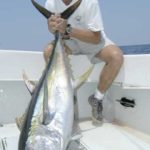
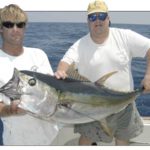
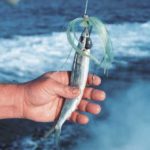
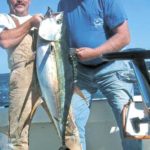
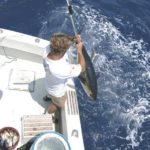
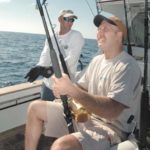


Be the first to comment